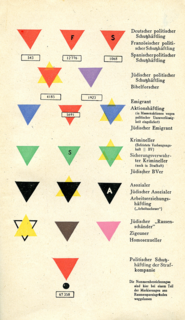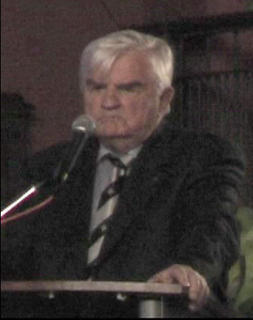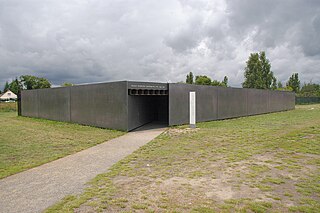Related Research Articles

Buchenwald was a Nazi concentration camp established on Ettersberg hill near Weimar, Germany, in July 1937. It was one of the first and the largest of the concentration camps within Germany's 1937 borders. Many actual or suspected communists were among the first internees.

Nazi concentration camp badges, primarily triangles, were part of the system of identification in German camps. They were used in the concentration camps in the German-occupied countries to identify the reason the prisoners had been placed there. The triangles were made of fabric and were sewn on jackets and trousers of the prisoners. These mandatory badges of shame had specific meanings indicated by their colour and shape. Such emblems helped guards assign tasks to the detainees. For example, a guard at a glance could see if someone were a convicted criminal and thus likely of a tough temperament suitable for kapo duty.

Gross-Rosen was a network of Nazi concentration camps built and operated by Nazi Germany during World War II. The main camp was located in the German village of Gross-Rosen, now the modern-day Rogoźnica in Lower Silesian Voivodeship, Poland; directly on the rail-line between the towns of Jawor (Jauer) and Strzegom (Striegau). Its prisoners were mostly Jews, Poles and Soviet citizens.

Mittelbau-Dora was a Nazi concentration camp located near Nordhausen in Thuringia, Germany. It was established in late summer 1943 as a subcamp of Buchenwald concentration camp, supplying slave labour from many Eastern countries occupied by Germany, for extending the nearby tunnels in the Kohnstein and for manufacturing the V-2 rocket and the V-1 flying bomb. In the summer of 1944, Mittelbau became an independent concentration camp with numerous subcamps of its own. In 1945, most of the surviving inmates were sent on death marches or crammed in trains of box-cars by the SS. On 11 April 1945, US troops freed the remaining prisoners.

Sachsenhausen or Sachsenhausen-Oranienburg was a German Nazi concentration camp in Oranienburg, Germany, used from 1936 until the defeat of Nazism in May 1945. It mainly held political prisoners throughout World War II. Prominent prisoners included Joseph Stalin's oldest son, Yakov Dzhugashvili; assassin Herschel Grynszpan; Paul Reynaud, the penultimate Prime Minister of France; Francisco Largo Caballero, Prime Minister of the Second Spanish Republic during the Spanish Civil War; the wife and children of the Crown Prince of Bavaria; Ukrainian nationalist leader Stepan Bandera; and several enemy soldiers and political dissidents.
A civilian internee is a civilian detained by a party to a war for security reasons. Internees are usually forced to reside in internment camps. Historical examples include Japanese American internment and internment of German Americans in the United States during World War II. Japan interned 130,000 Dutch, British, and American civilians in Asia during World War II.

Camp Fünfeichen was a World War II German prisoner-of-war camp located in Fünfeichen, a former estate within the city limits of Neubrandenburg, Mecklenburg, northern Germany. Built as Stalag II-A Neubrandenburg in 1939, it was extended by the officer camp Oflag II-E in 1940. After the Soviet takeover in 1945 until 1949 it was used as special camp, NKVD-camp Nr. 9 of the Soviet secret service (NKVD). Today, the site of the camp is a memorial.

Identification of inmates in German concentration camps was performed mostly with identification numbers marked on clothing, or later, tattooed on the skin. More specialized identification in Nazi concentration camps was done with badges on clothing and armbands.

John H. Noble was an American survivor of the Soviet Gulag system, who wrote two books which described his experiences in it after he was permitted to leave the Soviet Union and return to the United States.

Joachim Ernst, Duke of Anhalt was the last ruler of the Duchy of Anhalt.
Leopold Friedrich Franz Sieghard Hubertus Erdmann, Hereditary Prince of Anhalt was the head of the House of Ascania, the family which ruled the Duchy of Anhalt until 1918.

Niederhagen was a Nazi concentration camp on the outskirts of Büren-Wewelsburg which existed from 1941 to 1943 when it was disbanded.

Approximately three million German prisoners of war were captured by the Soviet Union during World War II, most of them during the great advances of the Red Army in the last year of the war. The POWs were employed as forced labor in the Soviet wartime economy and post-war reconstruction. By 1950 almost all surviving POWs had been released, with the last prisoner returning from the USSR in 1956. According to Soviet records 381,067 German Wehrmacht POWs died in NKVD camps. A commission set up by the West German government found that 3,060,000 German military personnel were taken prisoner by the USSR and that 1,094,250 died in captivity. According to German historian Rüdiger Overmans ca. 3,000,000 POWs were taken by the USSR; he put the "maximum" number of German POW deaths in Soviet hands at 1.0 million. Based on his research, Overmans believes that the deaths of 363,000 POWs in Soviet captivity can be confirmed by the files of Deutsche Dienststelle (WASt), and additionally maintains that "It seems entirely plausible, while not provable, that 700,000 German military personnel listed as missing actually died in Soviet custody."

NKVD special camps were NKVD-run late and post-World War II internment camps in the Soviet-occupied parts of Germany from May 1945 to January 6, 1950. They were set up by the Soviet Military Administration in Germany (SMAD) and run by the Soviet Ministry of Internal Affairs MVD. On 8 August 1948, the camps were made subordinate to the Gulag. Because the camp inmates were permitted no contact with the outside world, the special camps were also known as silence camps.

NKVD special camp Nr. 7 was a NKVD special camp that operated in Weesow until August 1945 and in Sachsenhausen from August 1945 until the spring of 1950. It was used by the Soviet occupying forces to detain those viewed as enemy of the people by the soviet regime.

Action 14f13, also called Sonderbehandlung14f13 and Aktion 14f13, was a campaign by Nazi Germany to murder Nazi concentration camp prisoners. Also called invalid or prisoner euthanasia, the sick, elderly and those deemed no longer fit for work were separated from the rest of the prisoners in a selection process, after which they were murdered. The Nazi campaign was in operation from 1941 to 1944 and later covered other groups of concentration camp prisoners.

Ravensbrück was a German concentration camp exclusively for women from 1939 to 1945, located in northern Germany, 90 km (56 mi) north of Berlin at a site near the village of Ravensbrück. The camp memorial's estimated figure of 132,000 women who were in the camp during the war includes about 48,500 from Poland, 28,000 from the Soviet Union, almost 24,000 from Germany and Austria, nearly 8,000 from France, and thousands from other countries including a few from the United Kingdom and the United States. More than 20,000 of the total were Jewish, approximately 15%. 85% were from other races and cultures. More than 80% were political prisoners. Many prisoners were employed as slave labor by Siemens & Halske. From 1942 to 1945, the Nazis undertook medical experiments to test the effectiveness of sulfonamides.

The NKVD Special Camp No. 1 was a special camp operated by the NKVD from 1945 to 1948, during the Soviet occupation of parts of Germany. It was located 4 km to the east of Mühlberg, Brandenburg using the shacks of the former German run prisoners-of-war camp Stalag IV-B. The prisoners mainly consisted of members of the lower and medium ranks of the Nazi party, German military personnel, youth wrongly accused of belonging to the German Werwolf resistance, and other persons who were regarded by the Soviets as being potentially dangerous like journalists, teachers, policemen, farmers, factory owners and politicians in addition to a number of arbitrarily accused people. Conditions in the camp were characterized by bad sanitary conditions, malnutrition and lack of basic medical service. The camp had over 21,800 prisoners during its existence, including 1,490 women and over 1,300 teenagers. At most, it held 12,000 prisoners at a time. In 1946, around 3,000 prisoners were deported to the Gulag in the Soviet Union. On 8 February 1947, a further 1,000 prisoners, mostly youth, were also deported to an NKVD Gulag camp in Siberia, the NKVD Camp No. 7503/11 in Anschero-Sudschensk. In summer 1948, two thirds of the prisoners were released. On 17 September 1948, the remaining 3,000 prisoners were transferred to another NKVD camp, Special Camp No. 2 in Buchenwald. From there, a part was released in 1950, the remaining prisoners were handed over from the Soviets to the East German Communist government and brought to Waldheim on 9 and 13 February 1950, only to be "convicted" in the infamous Waldheim Processes. The camp in Mühlberg ceased operations in 1948.
Helmut Bischoff was a German SS-Obersturmbannführer and Nazi official. During World War II he was the leader of Einsatzkommando 1/IV in Poland and later headed the Gestapo offices in Poznań (Posen) and Magdeburg.
References
- ↑ "WWII: Behind Closed Doors", Episode 6 of 6. BBC. Broadcast on BBC 2, on Monday 15 December 2008.
- ↑ Butler, Desmond (2001-12-17). "Ex-Death Camp Tells Story Of Nazi and Soviet Horrors". The New York Times. Retrieved 2010-04-27.
- 1 2 Cornelius, Kai Vom spurlosen Verschwindenlassen zur Benachrichtigungspflicht bei Festnahmen, BWV Verlag, 2004, p. 131, ISBN 3-8305-1165-5.
- ↑ Kinzer, Stephen (24 September 1992). "Germans Find Mass Graves at an Ex-Soviet Camp". The New York Times. Retrieved 27 April 2010.
- 1 2 Petra Weber, Justiz und Diktatur: Justizverwaltung und politische Strafjustiz in Thüringen 1945–1961: Veröffentlichungen zur SBZ-/DDR -Forschung im Institut für Zeitgeschichte, Oldenbourg Wissenschaftsverlag, 2000, p. 99, ISBN 3-486-56463-3.
- ↑ Cornelius, p. 128.
- 1 2 Weber, p. 100.
- ↑ Cornelius, pp. 126, 133–134
- ↑ Hunt, Ruth; Linke, Maria Zeitner (1977). East Wind. Oxford: Lion Hudson. ISBN 0-85648-080-0.